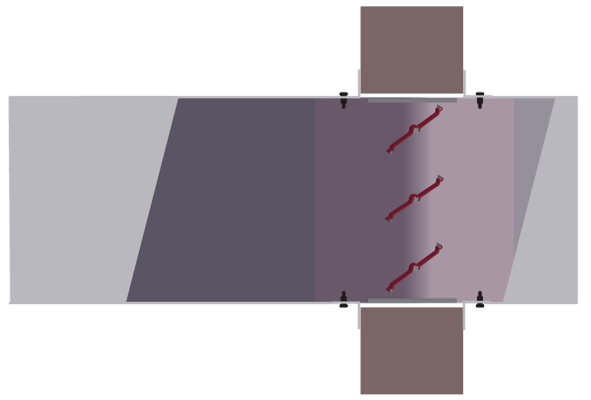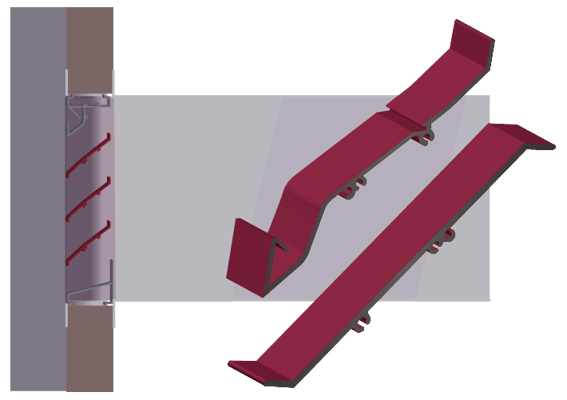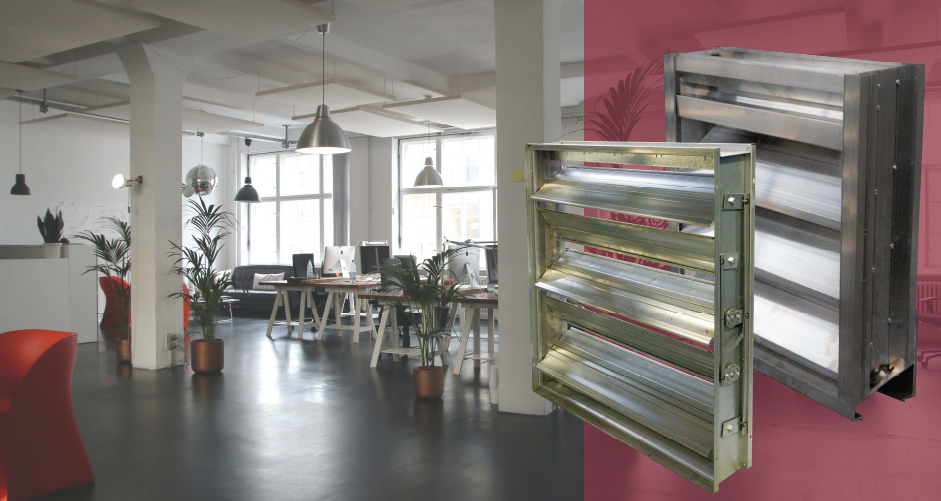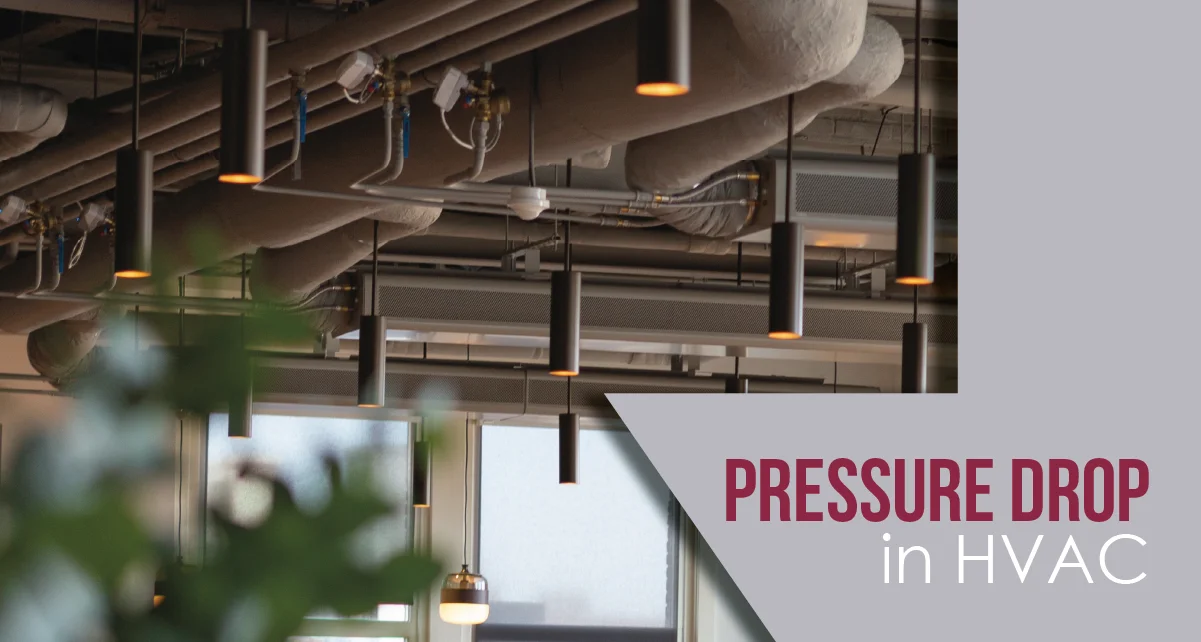HVAC systems need to keep air moving, but the required equipment comes at an unexpected cost. Read more about pressure drop in HVAC on the Newsstand.
Air Flow Control in HVAC
Your HVAC system moves air through your building. Whether you need to heat or cool a room, the system must draw air in through louvers and direct it to the right place with airflow dampers. These components are important to the system, but each louver and damper will cause a certain amount of pressure drop.

Starting a new project? Start with control dampers built for airflow. Check out the 517-518 series steel control dampers from Arrow United Industries. The 517-518 utilizes airfoil blades to regulate airflow with minimal effect on system performance. Contact Arrow United Industries today to get started.
What is Pressure Drop?
Pressure drop, or pressure loss, is the loss of air pressure as airflow passes over an object in the airstream. For louvers and dampers, pressure drop occurs when air moves through the free area . A greater pressure drop requires more power to drive the required amount of air through the system.
The Air Movement and Control Association (AMCA) have testing standards which measure the pressure drop of louvers and dampers. This data will be presented in the submittal, typically as a line graph, along with an AMCA CRP Seal for Air Performance.
There are two forms of pressure involved in airflow. Dynamic pressure drives air through the duct. Objects in the duct will generate static pressure as air passes over them. The difference between static and dynamic pressure is the pressure drop.
Dynamic pressure must exceed static pressure for air to pass through the duct. Technicians can increase the speed of system fans to increase the dynamic pressure to achieve the required airflow. This requires more power to meet the system’s needs.

You need louvers and dampers in place to keep your system running smoothly. Without louvers, there would be nothing to protect your ventilation points from rainfall and debris. An HVAC system with no dampers in place would have a tough time getting air to every part of your building. The best solution is to design your system for efficiency.
For more on HVAC dampers, check out these Newsstand articles:
- Five Things to Know When Selecting Dampers
- The Condenser - Product Spotlight: The 517-518 Series
- The Big Three Metals for Louvers and Dampers
- Balanced Flow - Static and Dynamic Pressure
Pressure Drop and Dampers
Dampers are installed throughout your HVAC system to keep air moving through the ducts. They can perform a variety of crucial functions, depending on their design. Most dampers are designed to fully open for airflow and close when airflow stops.
Other dampers can be set to partially open to modulate the flow or to equalize air pressure between ducts. There are several types of dampers for air control.

Regardless of their design, all dampers cause a certain amount of pressure drop. Any damper will create static pressure, even when the damper is fully open. Airflow damper blades will have few features along their profile, typically taking a single thickness profile or an aerodynamic airfoil profile.
Airfoil blades have a smooth, curved profile that allows air to flow across the blade surface with minimal resistance. Single thickness blades have a similar design, but the profile is flat and straight across the profile. Damper blades are designed for minimal effect on airflow when the damper opens. They should also close tightly when the damper closes.
Air leakage does not contribute to pressure drop, but it can negatively affect your HVAC system. Read more about its effects on air performance on the MCDLG Newsstand.
Pressure Drop and Louvers
Louvers are typically installed in ventilation openings along the envelope - the exterior walls - of your building. Their primary purpose is to keep rainwater and other damaging elements out of these openings. Louver blades have more features to prevent rainfall from infiltrating through the louver. These features are important, but they can also increase pressure drop.
For selecting the best louver, you will need to balance air performance with the louver’s requirements. If a project requires wind driven rain louvers in a ventilation opening, then you will choose wind driven rain louvers to fulfill those requirements. Consider the louver’s air performance capabilities once those requirements are met.

You will have several more options to consider when choosing a louver, including blade profile and blade action. Louvers can have straight blades, baffle blades, chevron blades, or other blade profiles designed for capturing rainfall.
For more on louver blades, check out “Louver Blades: A Primer”. Each of these blade profiles can also be drainable, which would add drain channels along the blade and a drain trough along the front of the blade.
Consider blades with fewer features when minimizing pressure drop. Straight blades have a flat profile, especially when they have no drain features. Air can pass across the blade with little resistance. Without drain features, water can more easily infiltrate the louver. Choosing the best louver means maintaining the best airflow while meeting all requirements.
Chevron blades often provide the best of both worlds. Their unique design allows air to flow through the louver with minimal resistance, while heavier elements like rainfall are rejected by the blade’s curve. Read more about Chevron blades on the Newsstand.
Minimize Pressure Drop
Dampers and louvers are necessary to keep air moving, and each unit will cause some pressure drop. Each point of pressure loss will require more power to push the same amount of air through the system. It is important to minimize pressure drop in your system, wherever you can.
An efficient HVAC system can get air to where it’s needed with minimal power. Always design to meet your requirements first. Focus on the testing data when selecting louvers for wind driven rain or hurricane requirements. Once your requirements are met, check the pressure drop data on the unit’s submittal. Make sure the unit doesn’t create excessive pressure drop during standard operation. An efficient system runs at its best with the right louvers and dampers.

Need help right away? Contact MCDLG today. We are ready to help you.
.webp?width=91&height=70&name=MCDLG%20Logo%20(Resize).webp)







